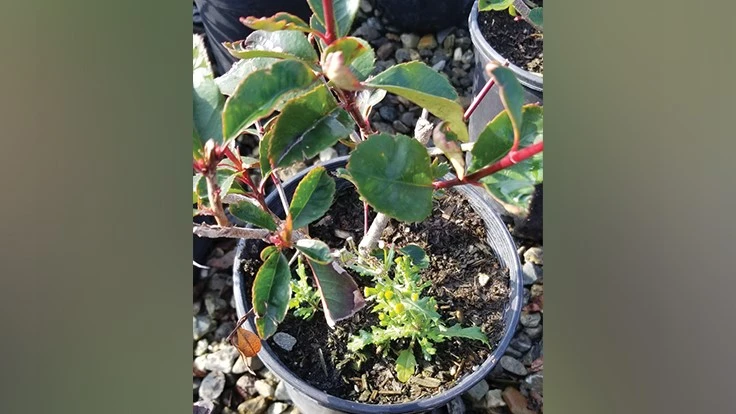

What does “funky” mean to you? For many, it can relate to smell, a rhythmic dance or even trendy clothing. But for Jen Browning, technical service specialist for western turf and ornamentals at BASF, the term “funky” relates to pests. In the third part of the Funky Pests series, Browning discusses a commonly overlooked issue that complicates pest management for growers.
“My funky pest is weeds in the greenhouse,” she says. “Weeds are competing for resources with our plants — they’re hogging water and nutrients. But the real reason why weeds are a funky pest is because they are a Trojan horse for insects and disease.”
According to Browning, weeds can be hosts to powdery mildew, aphids and other pests. If allowed to flower, there can be thrips hiding inside the buds, which essentially creates a reservoir of crop-visiting pests.
She says the weeds that grow under a bench or in between sidewalk cracks can be easy to overlook because scouts tend to focus on the plants where insects and diseases are more obvious. However, weeds can actually make the insect and disease pressure worse.

While most growers do pull greenhouse weeds, Browning says they’ll sometimes end up in an open trash can and hang out there for days, dispersing insects and disease back onto the crop.
“The spores and bugs bounce out of the trash can, or get transferred to workers who reach inside,” Browning says. “It spreads the pests around the greenhouse — but this can be remedied by something as simple a tight-fitting lid on the container and frequent trips to the main trash collection area.”
Some example of weeds that Browning classifies as detrimental to greenhouse cleanliness are algae and liverwort. They are a food source for shore flies, which in turn may transfer pathogens around the greenhouse. Because they eat algae and carry diseases — like powdery mildew spores — they add to the disease pressure by flying around and touching crops.
“They can transfer pathogens right onto the plants,” Browning says. “Meanwhile, the grower’s thinking, ‘Why do I keep having this problem? Where is it coming from?’ It’s coming from the weeds in the greenhouse. That’s why sanitation is so important.”
Weeds themselves are one of the lesser pests in greenhouses, so their impact on IPM can be overlooked — this is why Browning considers them to be funky.
“I think of funky as the unexpected,” Browning says. “Funky can be when you don’t know the pest or don’t know where it’s coming from.”
In her breakdown of pests, Browning — who is also a trained entomologist and horticulturist — categorizes them as “funky,” “maybe funky” and “not funky.”

“Funky pests” are the ones that surprise you, like weeds sneaking in bugs and disease. “Maybe funky” are the ones you need help identifying — maybe they are a problem, and maybe they’re aren’t. “Not funky” are the ones you recognize immediately and know how to deal with: aphids, mites, powdery mildew.
But Browning says even known pests like aphids and thrips can be funky because of their ability to create an unexpected situation. Aphids can build up large populations seemingly overnight, which Suzanne Wainwright-Evans mentioned in the previous Funky Pests article. (bit.ly/unusual-aphids). Browning notes that warm temperatures in greenhouses enhance rapid development of pest populations. “The higher the temperature, the faster they go from being an egg to a reproductive adult,” she says.
“And sometimes the pest isn’t who you think it is,” she says. “You may deploy an insecticide or biological control agent that doesn’t work — because the pest you are seeing isn’t the right target for that tool.”
But weeds aren’t so complicated. They hide in plain sight and there are some simple tricks to keep them from making your pest problems funkier than they need to be.
“Greenhouse sanitation is not a sexy topic,” Browning says. “People don’t want to spend a lot of time thinking about this — it’s boring! And it’s entwined with labor issues. We have fewer people to do more work than ever in the greenhouse, so pulling those weeds, even if they’re little, and quarantining them in a closed container works. Include the weeds you do see in your spray regimen — fungicides and insecticides should be applied to them as well between weeding cycles. These are some easy ways to help defunk the greenhouse.”

Explore the September 2019 Issue
Check out more from this issue and find your next story to read.
Latest from Greenhouse Management
- Meet the Next Gen: Gabriella Blair, Star Roses and Plants
- Leading Women of Horticulture: Katie Dubow, Garden Media Group, and Aubry Field, Lizzy Blossom
- Showing up at your horticulture business as your whole self
- Leading women of Greenhouse Management
- USDA fires experts on invasive pests, including Asian citrus psyllid, chilli thrips
- Farwest Show calls for 2025 New Varieties Showcase entries
- Leading Women of Horticulture: Arden Pontasch, North Creek Nurseries
- Leading Women of Horticulture: Emily Showalter, Willoway Nurseries







